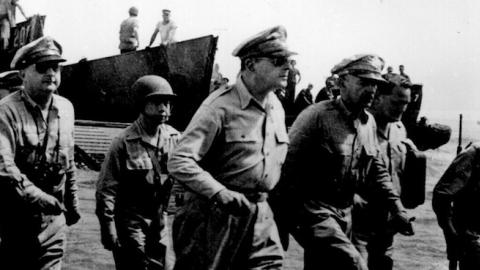The campaign for New Guinea during World War II has never drawn the same attention as the rest of America’s war in the Pacific. Mention Iwo Jima, Okinawa or Guadalcanal to most Americans and they can conjure up an image of heroism and endurance epitomized by the photograph of Marines raising the American flag over Mount Suribachi. But mention Buna and Biak—or other flashpoints in the New Guinea campaign—and you may well get a blank stare, unless someone had a grandfather who served in those precincts of hell.
James Duffy helps to fill this gap with “War at the End of the World,” a vivid and well-researched chronicle of a “forgotten fight” that was crucial to Allied victory. The book also restores Douglas MacArthur to his rightful place as one of America’s most successful battlefield strategists.
Certainly New Guinea was a god-awful place to fight a war. The world’s second largest island after Australia, roughly the size of California, it is covered with dense jungle and ribbed with steep mountain ridges. It is also subject to extreme heat, monsoon rains, poisonous snakes and tropical diseases. In a war in which victory increasingly depended on motorized transport and air power, New Guinea had virtually no roads to speak of and no level clearings for landing a small plane, let alone an air force.
The island (less than 100 miles from the northern tip of Australia) wouldn’t have become a battle ground were it not for the fact that the Japanese wanted to protect their empire’s southern flank and halt any Allied advance coming up from Australia. They aimed to do so by seizing New Guinea’s capital, Port Moresby—a move that the U.S. Navy initially halted at the Battle of the Coral Sea in May 1942. By then, MacArthur had arrived in Australia from the Philippines, where he had overseen a disastrous defeat by Japanese forces. Now he had to defend Australia from possible invasion by occupying New Guinea before the Japanese tried again.
That was going to be difficult. When he took command of the Southwest Pacific Area, MacArthur had virtually no American troops, almost no modern fighters or bombers, and an Australian ally that had little of the materiel needed to fight a determined enemy like Japan. Meanwhile, Japanese bombers pounded the port of Darwin and other targets almost daily.
It was assumed in Washington that MacArthur would be fighting a defensive war. Instead, Mr. Duffy writes, MacArthur used every opportunity “to request more men, more ammunition, more ships, and more planes to fight an aggressive war.’’ That meant a full-out fight for New Guinea. For the Americans, Mr. Duffy says, victory in New Guinea would be “pivotal in breaking the Japanese war machine”—and MacArthur was the man to break it.
After being repelled in the Coral Sea, the Japanese renewed their effort to take New Guinea in late July 1942, when they landed troops at the port of Buna on the island’s northeast coast and began pushing down the rugged Kokoda Trail toward Port Moresby. But MacArthur threw what troops he had into the battle for Kokoda and managed to halt the Japanese advance. Then, as more American men and materiel arrived in 1942-43, MacArthur began to pursue the New Guinea campaign at full throttle. He turned out to have four key advantages, which Mr. Duffy rightly highlights.
The first was his Australian allies, who proved tenacious jungle fighters and showed themselves willing to subordinate their own strategic interests to help MacArthur win. The second was Gen. George Kenney, commander of the U.S. Fifth Air Force, who understood that air power could isolate the enemy on the battlefield and take away its ability to maneuver. Kenney and his men would carve out from the jungle one air strip after another, which they used to support MacArthur’s drive toward the northern coast of New Guinea. Kenney’s strategy culminated in the Battle of the Bismarck Sea in March 1943, when his bombers, by themselves, virtually destroyed a Japanese convoy carrying almost 7,000 troops.
MacArthur’s third advantage was Adm. Daniel Barbey, a pioneer of amphibious warfare who used a steadily growing fleet of tank-landing and infantry-landing ships to help MacArthur surprise and envelop Japanese garrisons from the sea. It was Barbey, in fact, who enabled MacArthur to realize that he and Adm. William “Bull” Halsey—who was running a similar campaign in the Solomon Islands to the east—didn’t have to take by force the key Japanese garrison at Rabaul, a town on an island just north of New Guinea. Instead, by advancing with amphibious leapfrogs along New Guinea’s northern spine—and by snatching away Japan’s access to anchorages in neighboring islands—he and Halsey could isolate the Rabaul garrison and render it useless. And so they did. At the same time they were laying down the stepping stones to the liberation of the Philippines and setting the stage for fulfilling MacArthur’s promise, “I shall return.”
MacArthur’s fourth advantage was the information he received from the code breakers at his headquarters in Brisbane and back in Washington. Their biggest coup came in January 1944, when Australian troops discovered a trunk full of Japanese code books. To the end of the campaign, the code breakers were able to give MacArthur a detailed look at Japanese plans almost before he sat down to breakfast.
Even so, New Guinea saw fighting that can only be described as demonic. From MacArthur’s first assaults on Buna in the fall of 1942 through slugging matches for the neighboring islands of Biak and Wakde in 1944, his soldiers fought an enemy that was both well-entrenched and determined to die rather than surrender. The fighting was often hand to hand, grenade to grenade, bayonet to bayonet.
For the soldiers themselves, it was a living hell. Mr. Duffy quotes correspondent E.J. Kahn Jr. describing the Americans he met who were serving with the 32nd Division during the fight for Buna: “They were gaunt and thin, with deep black circles under their sunken eyes. They were covered with tropical sores. . . . Often the soles had been sucked off their shoes by the tenacious, stinking mud. Many of them fought for days with fevers and didn’t know it.”
If anything, things were worse for the Japanese. A chronic lack of food reduced many of them to cannibalism; anyone who fell into the hands of the island’s indigenous were liable to be killed and eaten in their turn.
The last major fighting in a campaign that cost America and Australia some 42,000 killed and wounded, and Japan more than 127,000 lives, was at Morotai Island (in present-day Indonesia), in September 1944. When it was over, MacArthur could gaze out across the Morotai Straits toward Leyte in the Philippines. “They are waiting for me there,” MacArthur murmured to one of his subordinates. “It’s been a long time.” The rest of us have been waiting a long time for a book like “War at the End of the World,” which gives those who were part of this forgotten fight the recognition they deserve.
















